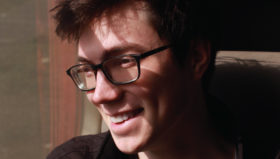The Future of Rural with Ryan Schnurr
November 27, 2020This November, Indiana Humanities is focusing on our One State / One Story selection, Jean Thompson’s The Year We Left Home. The Year We Left Home explores ideas of rural, urban and suburban experiences,…
This November, Indiana Humanities is focusing on our One State / One Story selection, Jean Thompson’s The Year We Left Home. The Year We Left Home explores ideas of rural, urban and suburban experiences, the American Dream and how we connect to a place. To help us explore these ideas further, we’re connecting with Hoosiers who have unique perspectives to share on the future of rural.
Today we’re talking to Ryan Schnurr. Ryan is a writer and the editor of Belt Magazine. He is the author of In the Watershed: A Journey Down the Maumee River.

Tell us about yourself and your work with Belt Magazine.
I was born and raised in Fort Wayne, Indiana. I went to school in Huntington, Indiana; Chicago, Illinois; and West Lafayette, Indiana (I’m still in the dissertation phase of a PhD at Purdue). Now I’m back in Fort Wayne, where I also edit stories for Belt Magazine.
What stories and perspectives does Belt Magazine focus on sharing?
Belt’s mission is to be a publication “by and for” the Rust Belt. In practice, that means we publish features, essays, commentary, photography, and poems about the past, present, and future of the region by people who live here or have some connection to it. For Indiana, this means everything from a feature on Bob Ross’s time in Muncie, to a history of Unigov in Indianapolis, to a personal essay on traveling through a former Sundown Town as a young Black girl.
What kind of conversations is Belt trying to raise about rural America?
There are a lot of oversimplified ideas knocking around about rural places, and most of them are just not a fair or useful reflection of what it’s like to live there. Rural America, like every place else, has a lot of challenges but also a lot of opportunities. There are also a bunch of smart, creative, resilient people out there, and they don’t need to be pandered to.
So, basically, we want to invite our readers and writers to think alongside each other about the racial realities, the economic realities, the environmental realities of these places, among others. Get into the histories of exclusion and economic exploitation, but also creativity and solidarity. And, ideally, we’ve got people who know those places, who are connected to them in some meaningful way, doing the writing.
What are some of the previously untold stories of midwestern life that Belt has worked to publish?
I don’t know about untold stories, but I think we tell a lot of stories in a way they might not be popularly told. I’m thinking of an essay we published earlier this year on “hang-arounds”—or loiterers—in Mt. Jewett, a small community in Pennsylvania. It turns out these hang-arounds, who are most often, I think, dismissed as a negative, really meant something to the town. The writer, Jake Maynard, talks about them as a pretty integral part of his growing-up years, and how they “bore witness” to what happened there as the town began to struggle. I think that’s a good example of thinking more expansively about a community and its people.
Probably one of my favorite stories we’ve ever published was a reported feature a couple of years ago on prisons and population. Basically, a lot of people arrested in urban areas are incarcerated in rural areas. And the U.S. Census counts incarcerated people in the counties of residence, so you can have towns where the population is really skewed. That has implications for things like electoral power. The writer—Kim Bellware—does a great job, I think, of describing how the prison industry links rural and urban areas in really complicated ways.
Are there any writers or works from Belt Magazine or Belt Publishing that discuss the future of rural America that you recommend people check out?
Well there’s a book published by Belt Publishing, which is a sibling project to Belt Magazine, called, if you can believe it, “Midwest Futures.” It’s excellent. There’s another piece on the magazine, by Sam Love, about how the Lake County Fair can help us see a different future. But those are just examples with “future” in the name. Frankly, I think everything we publish on the magazine—from really smart, thoughtful people like Ava Tomasula y Garcia, Avery Gregurich, and Njaimeh Njie—relates to the future of the region because probably the best way to get a sense of what’s coming is to look hard at what’s already happened and what’s happening now. That’s a non-answer, but I think it’s accurate.
By the way—I don’t really think we need to (or should) talk about the future of rural America without talking about the future of urban, suburban, and small-town communities. Because their systems and institutions are interlinked, and the same patterns of wealth, exploitation, pollution, etc. show up everywhere. We’re all links in the same chains.
Our statewide read, The Year We Left Home, asks us to think about how we connect to a place. As a Hoosier and a writer, how do you feel connected to Indiana?
I consider myself an Indiana writer. It’s pretty clear that my work is shaped and informed by my experiences in this place, which constitute the vast majority of my living experience. Also, my lineage is pretty thick in the area. People on both sides of my ancestry have been living and working in Indiana, or nearby, for more than a hundred years—in some cases a hundred and fifty. My family bones are buried here. I could hardly be anything else.


